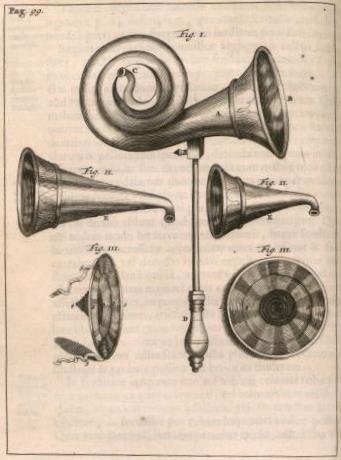
We might take it as a given that our hearing aids are scarcely detectable, can be operated with our smart phones, and can differentiate between speech and background sound. What we might not realize, however, is that those functions are the products of 400 years of experiment, design, and development.
Even as early as 5 years ago, hearing aids could not deliver the clarity of sound generated today. To understand why, let’s follow the history of hearing aids—beginning today and going in reverse—to see how hearing aids would have handled your hearing loss in four different years: 2016, 1985, 1940, and 1650.
2016 – Modern Digital Hearing Aids
It’s 2016 and you’re searching to treat your hearing loss. You open up a web browser, search for a community hearing care professional, fill out a quick form, and arrange a consultation.
At your hearing exam, your hearing is tested using state-of-the-art computer technology that accurately evaluates your hearing. Then, with the help of your hearing expert, you pick out a hearing aid that complements your needs from an extensive range of models.
Then, your hearing professional programs your new hearing aids to amplify only the sounds and frequencies you have trouble hearing, giving you crystal clear sound without distortion.
If you were to tell anyone in the 1980’s that this would be the process, they wouldn’t have believed it was possible.
So what did render it possible? In essence, digital technology.
For most of their history, there was no way for hearing aids to differentiate between assorted sound frequencies. Hearing aids would enhance all incoming sound, including background noise, generating distorted sound.
The digital revolution addressed that issue. With digital technology, all information can be altered, saved, and manipulated as permutations of 0’s and 1’s. Digital technology allowed hearing aids to transform sound frequencies into digital information, which could then be sorted in accordance with which sounds should be amplified (speech) and which should be restrained (background noise).
The first all-digital hearing aid was produced in 1995, and since then the technology has improved exponentially, eventually to incorporate wireless capability.
1985 – Transistor Hearing Aids
Now, imagine it’s 1985 and you’re looking to treat your hearing loss. You can forget browsing for a local hearing care provider on the internet because the first commercial internet service provider won’t be founded until 1989.
You’d need to use the yellow pages, rely on recommendations, or drive around the neighborhood to find a hearing care practice.
After scheduling a consultation and having your hearing examined, your options for hearing aids are quite restricted. With no microprocessor and digital technology, hearing aids were engineered with a series of transistors. This adds size and higher power requirements, resulting in larger batteries and massive hearing aids.
Also, without the advantage of digital technology, the hearing aid cannot differentiate between various frequencies of sound. Hearing aids receive incoming sound and the transistors act as basic amplifiers, amplifying all sound. So if you’re in a loud room, speech recognition will be just about impossible.
1940 – Vacuum Tube Hearing Aids
It’s 1940 and you’re contemplating acquiring a hearing aid. Transistors haven’t been applied to hearing aids yet, so your choices are confined to vacuum tube hearing aids.
Vacuum tubes utilize more power than transistors, so the hearing aids require larger batteries, making the hearing aids large, heavy, and awkward.
And once again, without digital technology, the hearing aids can only act as basic amplification devices, making all incoming sound louder. The hearing aids can’t enhance speech and cannot remove background noise.
1650 – Ear Trumpets
Let’s go all the way back to 1650. There’s no digital technology, no transistors, and no vacuum tubes. That means no way to transform sound into electrical currents that can be amplified.
With electrical amplification unattainable, your only possibility is mechanical amplification by focusing and compressing sound into the ear canal, as with what takes place when you cup your hands around your ears.
By 1650, products were developed that concentrated incoming sound into the ears, and these devices were called ear trumpets. They were large gadgets with a conical end that collected sound and a narrow end that focused the sound into the ear.
This would be the only technology accessible to individuals with hearing loss for the next 250 plus years.
Let’s return to 2016. Over the course of more than 400 years of history, hearing aids have evolved from mechanical amplification devices to electrical amplification devices, from vacuum-tube-based to digital-based. They’ve become significantly more compact, lighter, and more efficient and affordable.
They’ve also become much better at distinguishing among various types of sound, and in amplifying only specified types of sound (such as amplifying speech while suppressing background noise).
Every generation of hearing aid has produced a major enhancement over the previous generation. The question is, what’s the next major benchmark in the history of hearing aids?
Will we soon be able to enhance natural human hearing, rather than simply restore it?
